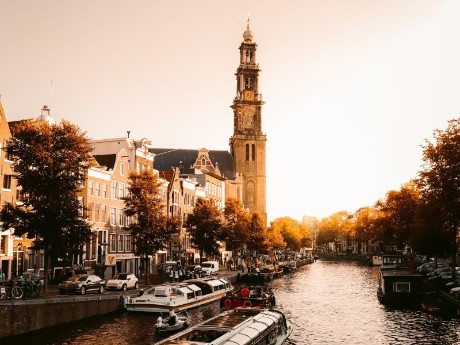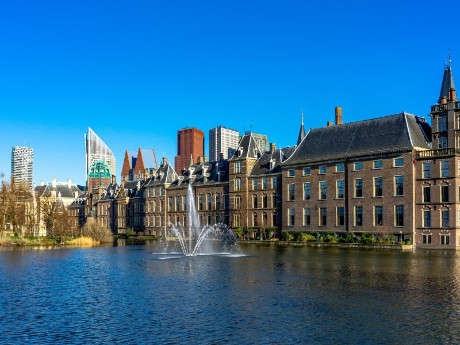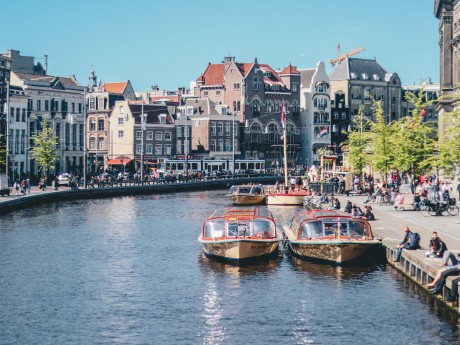Netherlands: Amsterdam & The Hague
Embark on a journey to the Netherlands, where history, culture, and picturesque landscapes seamlessly combine. In Amsterdam, explore the intricate canal system on a relaxing boat cruise, offering a captivating perspective of iconic landmarks and charming neighbourhoods. The Rijksmuseum, showcasing Dutch masterpieces, and the vibrant Anne Frank House provide cultural immersion and historical insights. A short drive or bus will take you to your next stop, The Hague.
Read more
Embark on a journey to the Netherlands, where history, culture, and picturesque landscapes seamlessly combine. In Amsterdam, explore the intricate canal system on a relaxing boat cruise, offering a captivating perspective of iconic landmarks and charming neighbourhoods. The Rijksmuseum, showcasing Dutch masterpieces, and the vibrant Anne Frank House provide cultural immersion and historical insights. A short drive or bus will take you to your next stop, The Hague. Unwind on the sandy shores or indulge in various water sports at Scheveningen Beach or wander through the beautifully landscaped gardens at Peace Palace.Together, these cities encapsulate the Netherlands' diverse offerings, making a trip to this captivating country a must for those seeking a harmonious blend of history, art, and natural beauty. Waterviews strives to offer accommodation options within walking distance of water and/or in an area of touristic interest. Our prices include taxes (but excludes local tourist taxes). Customize your trip to your personal preferences with optional activities (hit the “Add Activities’’) or change hotels, etc. Contact us for customization at no extra cost at: Service@waterviewstravel.com
Destinations
- Amsterdam
- The Hague
Itinerary
Amsterdam

Renowned for its stunning canals, impressive architecture and diverse cultural scene, Amsterdam is the Netherlands’ vibrant capital city. Admire incredible buildings that date back to the Dutch Golden Age, marvel at masterpieces in the world-class Rijksmuseum, wander in labyrinthine lanes, or do as the locals and cycle through the vast Vondelpark before enjoying Amsterdam’s plethora of excellent restaurants, cafes and bars. Whether you’re looking for history, culture, shopping or nightlife, this city has it all.
Read more
Renowned for its stunning canals, impressive architecture and diverse cultural scene, Amsterdam is the Netherlands’ vibrant capital city. Admire incredible buildings that date back to the Dutch Golden Age, marvel at masterpieces in the world-class Rijksmuseum, wander in labyrinthine lanes, or do as the locals and cycle through the vast Vondelpark before enjoying Amsterdam’s plethora of excellent restaurants, cafes and bars. Whether you’re looking for history, culture, shopping or nightlife, this city has it all.
Additional Information
Settled as a small fishing village in the late 12th century, Amsterdam became one of the most important trading centres in the world during the Dutch Golden Age of the 17th century. The city's small medieval centre rapidly expanded as the Jordaan and the Canal District were constructed; the latter's cultural significance was acknowledged when it became a UNESCO World Heritage Site in 2010. In the 19th and 20th centuries, the city expanded in all directions, with many new neighbourhoods and suburbs designed in modernist styles.
Amsterdam is not the seat of the government, which is in The Hague. Partly because of this, the city has an informal atmosphere unlike other capital cities its size. In fact, Amsterdam has a history of non-conformism, tolerance and progressivism. Attractions include the Rijksmuseum, Van Gogh Museum, Anne Frank House, Magere Brug, Albert Cuyp Market and the Vondelpark.
Orientation
The "Amsterdam" that most visitors experience is the city centre, the semi-circle with Centraal Station at its apex. It corresponds to the city as it was around 1850. Five major concentric canals ring the Binnenstad: Singel, Herengracht, Keizersgracht, Prinsengracht and Singelgracht, together forming the Canal District. Other districts inside the city centre are the Jordaan, a former working class area now popular with yuppies, and Plantage, a leafy and spacious area with botanical gardens and the zoo. The Nassaukade, Stadhouderskade and Mauritskade surround the city centre and mark the location of the former city moat and fortifications. Almost everything outside this line was built after 1870.
The semi-circle is on the south side of the IJ, which is often called a river but more exactly is an estuary. Going east from Centraal Station, the railway passes the artificial islands of the redeveloped Eastern Docklands. North of the IJ is mainly housing, although a major dockland redevelopment has started there too.
The river Amstel flows into the city from the south. Originally, it flowed along the line Rokin-Damrak. The dam in the Amstel, which gives the city its name, was located under the present Bijenkorf department store near Dam Square. The original settlement was on the right bank of the Amstel, on the present Warmoesstraat: it is therefore the oldest street in the city. The city has expanded in all directions, except to the northeast of the A10 ring motorway. That area is a protected rural landscape of open fields and small villages considered a part of the Waterland region.
The radius of the semi-circle is about 2 km. All major tourist destinations, and most hotels, are located inside it or just outside it. As a result, a large swathe of Amsterdam is not visited by the average tourist: at least 90% of the population lives outside this area. Most economic activity in Amsterdam—the offices of the financial sector, the port—is near or outside the ring motorway, which is 4–5 km from the centre.
The expansion of Amsterdam outside the ring motorway and the expansion of activity outside the city centre is redefining what locals consider the 'central area' of Amsterdam. Zuid, especially with the construction of the Noord/Zuidlijn and the Zuidas, is becoming more and more important in the daily lives of the locals. Its significance for tourists has increased by the now completed reconstruction work on the Museumplein and the adjoining museums.
History
Amsterdam was first referred to as Aemstelledamme ("dam on the Amstel") in 1204, and known as Aemsterdam by 1327. It was first part of Utrecht, and around 1300 Gwijde van Henegouwen, bishop of Utrecht, gave Amsterdam city rights. After his death, the city was inherited by Count William III and became a part of Holland. Two fires swept the city in 1421 and 1452, and few wooden buildings from this period remain. A notable exception is the Houten Huis (Wooden House) at the Begijnhof.
In 1558, the Dutch started to revolt against the Spanish as the local nobility demanded more political power and religious freedom. Amsterdam supported the Spanish, but as it became more and more isolated and trade suffered accordingly, it switched sides in 1578. A relative freedom of religion emerged in the newly established Dutch Republic, and many migrants sought refuge in Amsterdam, including Jews from the Iberian Peninsula, merchants from Antwerp and Huguenots (French Protestants). Catholicism could not be practiced openly.
Amsterdam prospered in the 17th century and became one of the world's great cities. A global trading network and overseas possessions made Amsterdam the centre of shipping in Europe and the world's leading financial centre. The arts flourished too, with great painters like Rembrandt producing works that are widely acclaimed as of this day. The city expanded outside of its original boundaries as the Canal Belt was constructed for wealthy merchants and the Jordaan for the working class. Immigrants formed the majority of the population and there was a strong immigration from Lutheran Protestant Germans.
The Dutch Republic was not a unitary state, but a confederation in which the independent provinces and the larger cities were politically autonomous. There was a strong animosity between the Orange faction with its power base in The Hague and the republican faction with Amsterdam as its most outspoken representative, up to the point that the city was beleaguered by the army. The Orange faction supported the idea of hereditary political leadership vested in the princes of Orange as Stadtholders, while the republican faction supported civic independence. This long-standing culture of republicanism and non-conformism against the political elites in The Hague exists to this day.
The 18th and 19th centuries were a turbulent period for Amsterdam. The economy suffered from decreased trade opportunities with the colonies and ongoing wars with the United Kingdom and France. Napoleon's brother Louis was crowned King of Holland in 1806 and took possession of the city hall on Dam Square, from then on referred to as the Royal Palace. The Netherlands was fully annexed by France in 1810, and Napoleon crowned Amsterdam "third city" of the French Empire. Prussian and Russian troops liberated the Netherlands, but it remained a unitary state and a monarchy, that now included Belgium.
While The Hague had functioned as de facto capital of the Republic, Amsterdam (together with Brussels) became the new capital of the Kingdom. The appointment of Amsterdam as the new capital was a conciliatory gesture of the Orange faction towards the city and a recognition of the strong civic and republican basis of the new Kingdom. The Hague remained the seat of government and the political centre of the country. When Belgium seceded in 1830, Amsterdam became the sole capital and got the rights to trade with the country's overseas possessions.
The North Sea Canal and Noordhollandsch Kanaal connected Amsterdam's harbour directly with the Rhine and the North Sea. The Industrial Revolution arrived around 1860, which led to strong economic growth, but also to overpopulation as the city could not cope with the sudden demographic surge. The Jordaan was a notorious working class slum in this period, and neighbourhood like De Pijp were built to provide housing as cheaply and quickly as possible for the lower middle class. Social issues that arose in this period made Amsterdam the centre of social democracy in the country.
In World War II, German troops occupied the city and more than 100,000 Jews were deported to death camps, most famously Anne Frank. The diamond trade, before the war one of Amsterdam's top industries, almost completely disappeared as these businesses were mostly in the hands of Jews. The cultural revolution of the 1960s and 1970s changed Amsterdam radically. Soft drugs were tolerated, squatting became commonplace and riots with the police occurred on a daily basis. The coronation of Queen Beatrix in 1980 turned violent as protesters demanded a stop to the housing demolition that took place for the construction of Amsterdam's first metro line.
In subsequent decades, Amsterdam has lost some of its revolutionary appeal, becoming a centre for wealthy yuppies. Once poor districts like the Jordaan became upper class districts, and poorer inhabitants moved out of the centre to the outer boroughs and other cities. The city's once progressive ideals have faded as squatting is cracked down on, coffeeshops are increasingly closed and prostitution is outlawed outside of the Red Light District. However, it is still a progressive and tolerant city by international standards. Its culture of republicanism and non-conformism are going through tough times as well, but the ubiquitous "Republic of Amsterdam" street signs show that it remains a defining characteristic of the city.
Climate
Amsterdam is a large city and a major tourist destination, so you can visit it all year round. However, in winter the days are short (8 hours daylight around Christmas), and the weather may be too cold to walk around the city comfortably, let alone cycle. January and February are the coldest months, with lows around 0°C (32°F) and highs around 5°C (41°F). July and August are the warmest months, with an average temperature of 22°C (72°F) at daytime.
Neither summer nor winter constantly have the mentioned values. In summer, heat waves (3 days above 30°C/86°F) are common, as is a temperature of 18°C (64°F) with rainfall. Snow does occur a few times each winter, but it's often light and rarely stays on the ground more than a couple of days. Always be prepared for rain. On average it's raining one in every two days, but it might as well be raining the full week of your trip. Gray clouds cover Amsterdam most of the time in winter and it rains a lot, but in spring and summer the sun shines six to eight hours a day on average.
King's Day (Koningsdag) is always celebrated on 27 April, unless this date occurs on a Sunday (then it's celebrated the Saturday before). The weather on King's Day is usually quite good with temperatures hovering around 17°C (63°F). If it's raining, there will be considerably fewer people on the streets.
Tourist information
© Sourced from Wikivoyage
The Hague

Renowned for being home to some of the country’s finest museums as well as a number of Dutch government buildings, the Netherlands’ third city is well worth the visit. Once overlooked by visitors, today The Hague’s lovely coastal setting, experimental culinary scene and rich culture has made it a firm favourite. Its compact centre can be easily explored in a couple of days on foot or by bike, and its nearby sandy beaches make it perfect for both city breaks and relaxed getaways.
Read more
Renowned for being home to some of the country’s finest museums as well as a number of Dutch government buildings, the Netherlands’ third city is well worth the visit. Once overlooked by visitors, today The Hague’s lovely coastal setting, experimental culinary scene and rich culture has made it a firm favourite. Its compact centre can be easily explored in a couple of days on foot or by bike, and its nearby sandy beaches make it perfect for both city breaks and relaxed getaways.
Additional Information
Internationally, The Hague is often known as the "judicial capital of the world" due to the many international courts that are located in the city. Among these are the International Court of Justice, the International Criminal Tribunal for the former Yugoslavia and, since 2004, the International Criminal Court. Beside these institutions, The Hague is home to more than 150 international organizations, and to many EU institutions, multinational companies and embassies. This gave the city a distinct international character — one that is noticeably different from Amsterdam. Rather than having the many foreign tourists and fortune-seekers attracted by Amsterdam's reputation for excitement and liberalism, The Hague generally has more expatriates working and living in the city because of the number of international institutions and companies. Because of this, The Hague has a reputation as a wealthy, conservative and somewhat sedate city.
The Hague has very little of the edginess and excitement of Amsterdam; however, it provides well for its inhabitants in different ways, such as large areas of green space, 11 km of coastline, attractive shopping streets and an extensive multicultural scene. Rather than having canals like other Dutch cities, The Hague has streets and avenues that are just a little bit wider than those in the rest of the country, giving the city a more continental feel. Instead of the typical Dutch renaissance 17th-century step-gabled houses, it has 18th-century mansions in baroque and classicist styles. The city is considered by many as the most stately of the country. Just outside the city centre, posh neighbourhoods effuse a more 19th century look with eclectic and art nouveau architecture.
The farther you get from the sea front and the city centre, however, the more neighbourhoods tend to become less well-off. One dividing line between affluent and sketchier areas is drawn by some at Laan van Meerdervoort, which runs parallel to the seaside. Areas away from the sea tend to have much less in the way of green space. An exception to this is one centrally located park, Zuiderpark, which also used to contain the stadium of the local football team ADO Den Haag. Some of its supporters were known as the most notorious hooligans of the country, perpetuating a stereotype of "lower-class" for the inhabitants of that area.
The Hague offers great architecture, from the picturesque government complex of the Binnenhof, to the grand and stately mansions on Lange Voorhout. Museums like the Mauritshuis rank among the best in the country. For food aficionados, The Hague offers some of the country's best Indonesian cuisine, due to large-scale immigration from this former Dutch colony. The city also offers good opportunities for outings, such as extensive green spaces for walking and bicycling as well as dunes and seaside recreation areas just a few tram stops away from the city centre. The Hague also offers a few attractions especially appealing to children, such as the miniature city of Madurodam and the 360 degree Omniversum cinema.
Over recent decades, the city has undergone an extensive amount of development in the form of modern architecture projects. Recent constructions include the City Hall and Central Library by American architect Richard Meier, De "Snoeptrommel" (known by the locals as Candy-Box) - a round shopping centre next to the old town hall, and a collection of post-modern, brick-clad office towers in between the city hall and the Centraal railway station, which provide new housing for a number of ministries. A major infrastructural development has been the construction of an underground tram tunnel underneath Grote Marktstraat, which is used by regular trams, and a new light-rail system, known as RandstadRail, linking The Hague with the neighbouring cities of Zoetermeer and Rotterdam.
A major redevelopment project is underway in the area around the Centraal railway station. Here, skyscrapers like the 142 m Hoftoren rise up over the city and several other high-rise towers are under construction.
Tourist information
© Sourced from Wikivoyage





